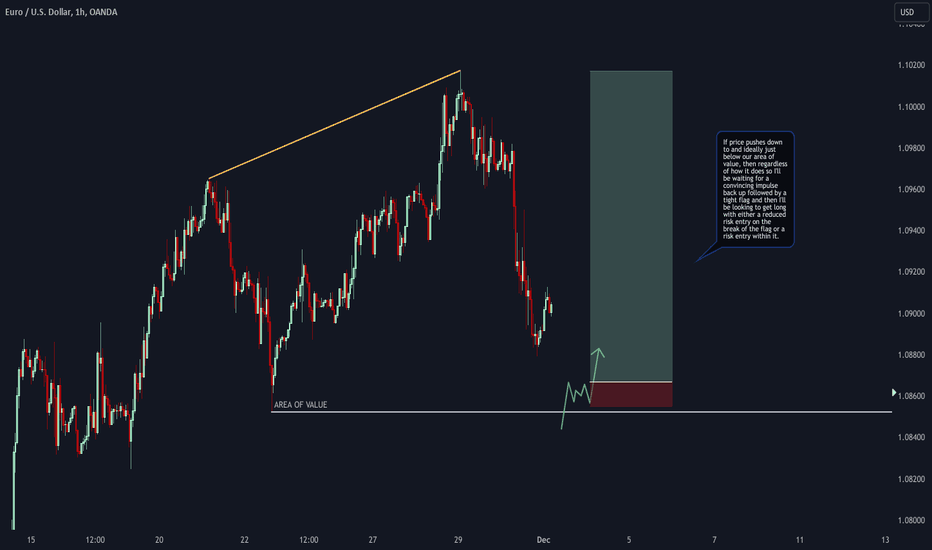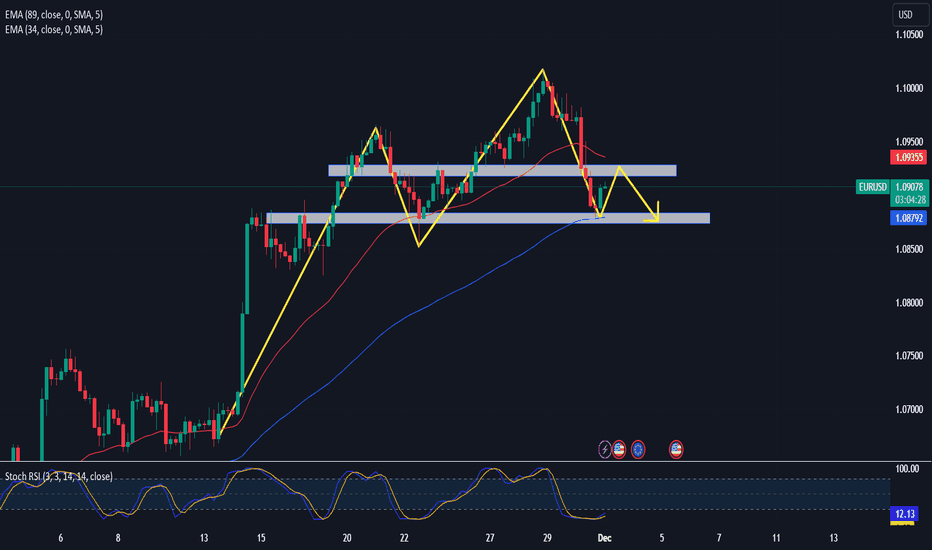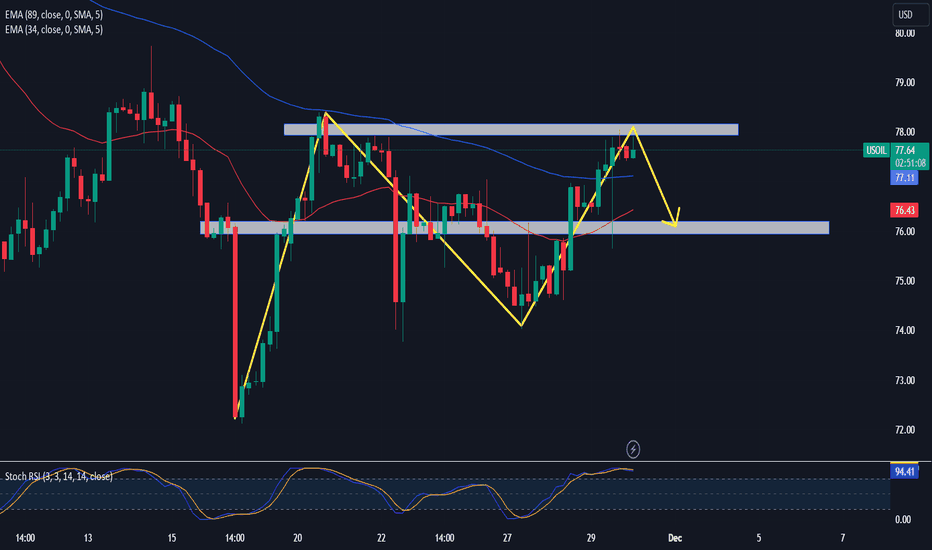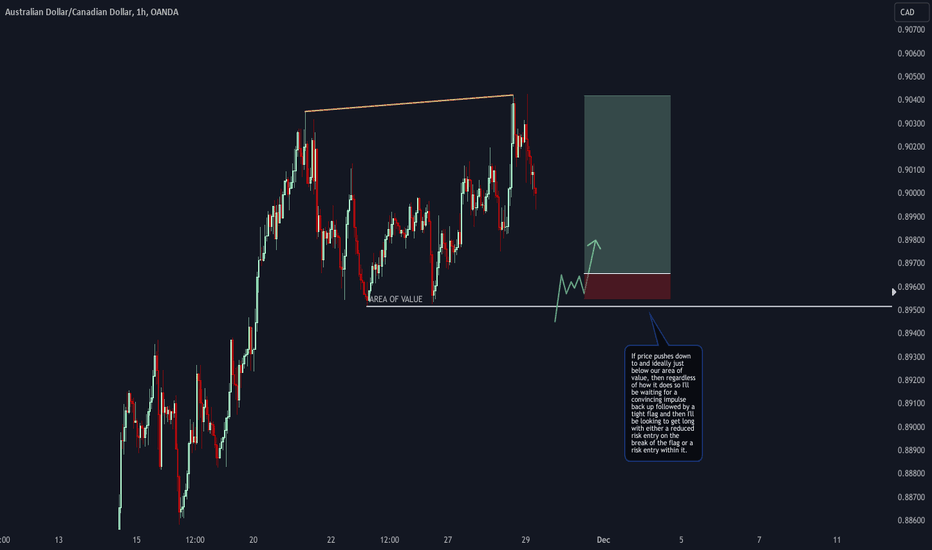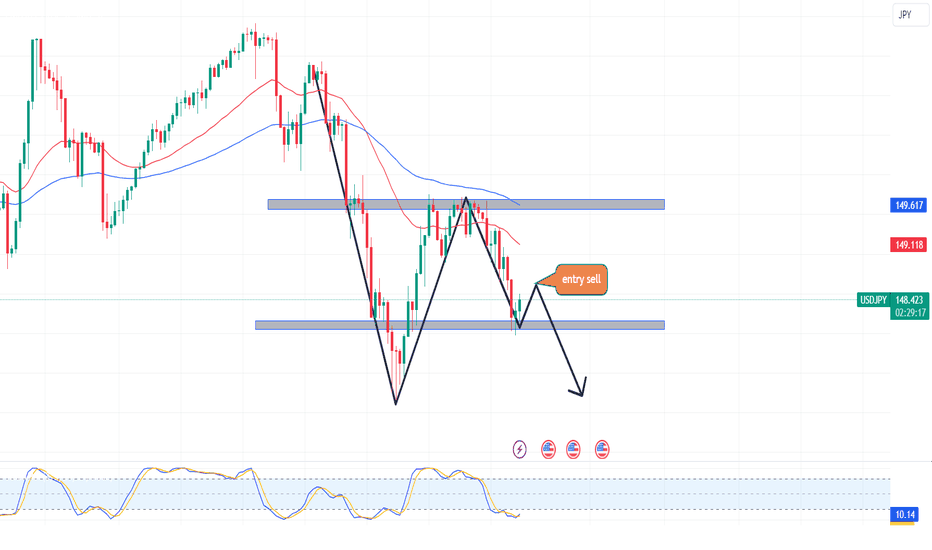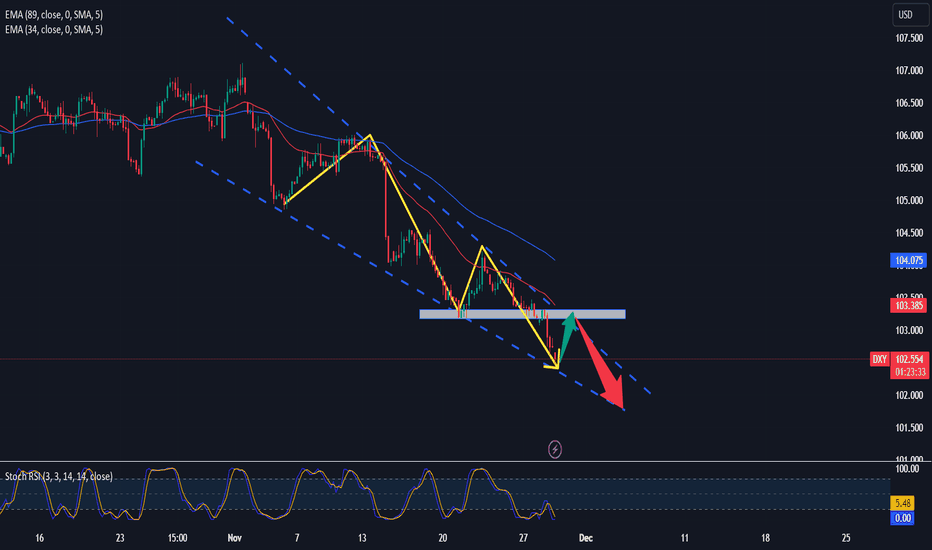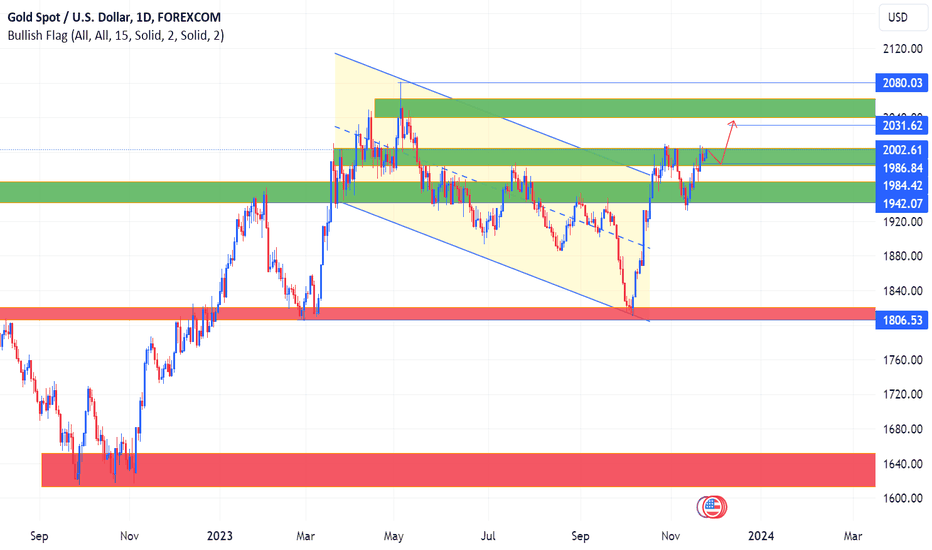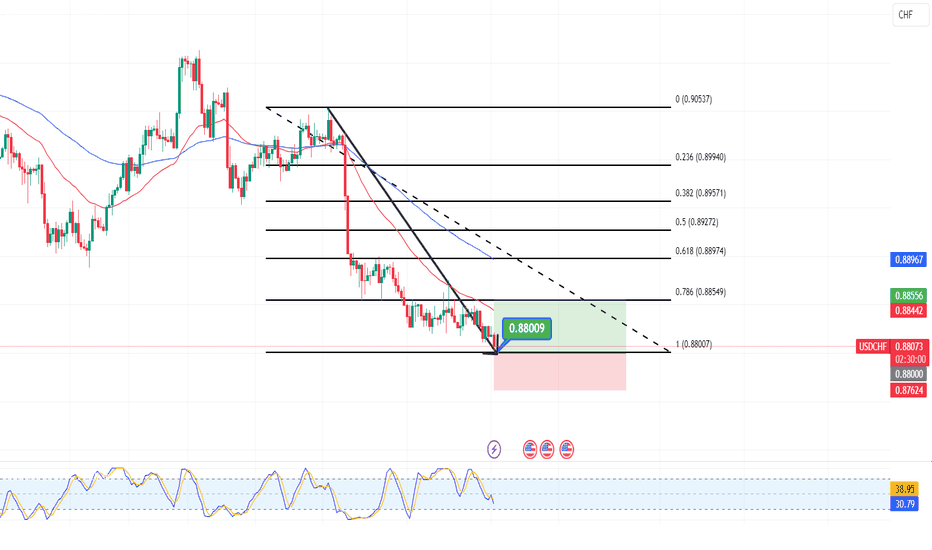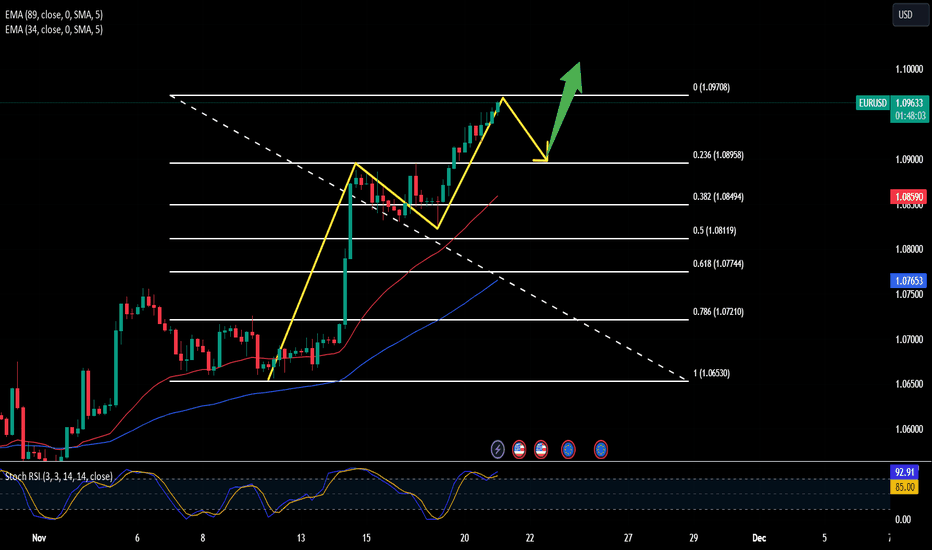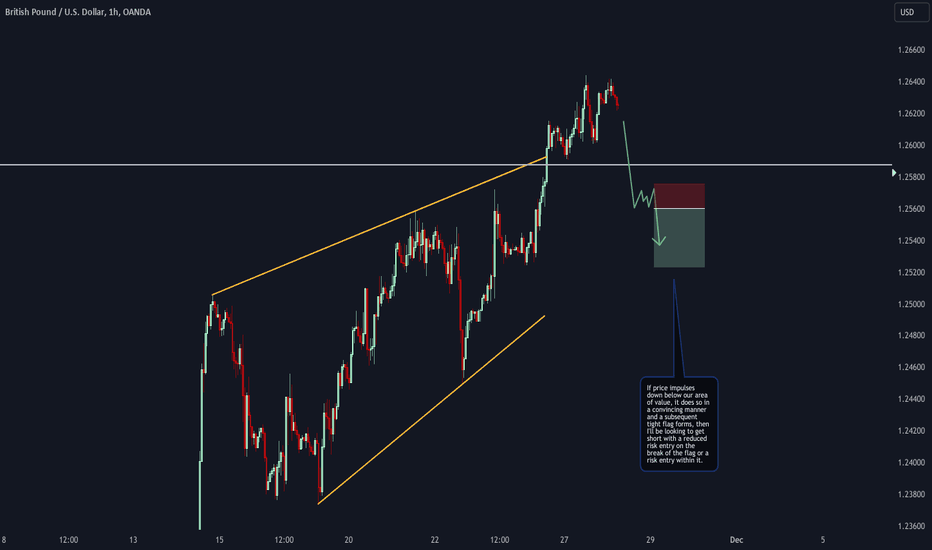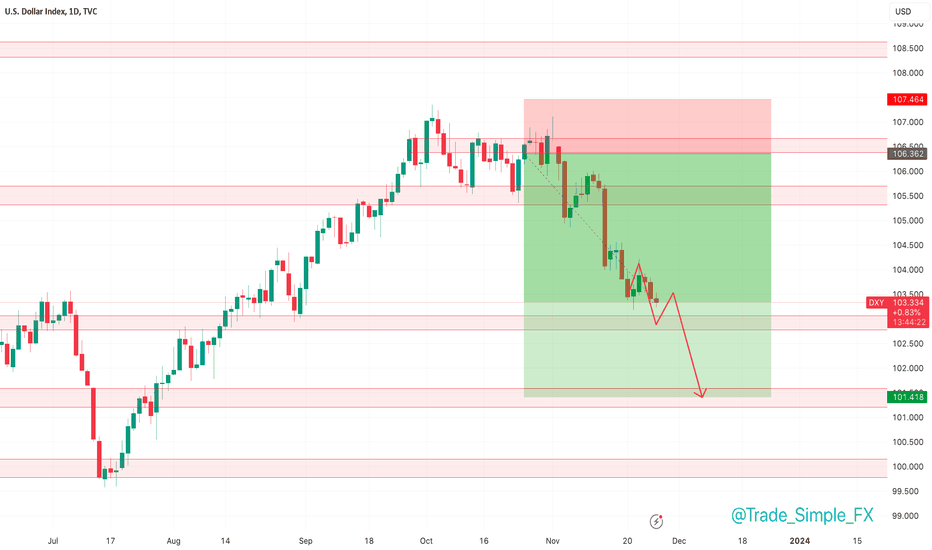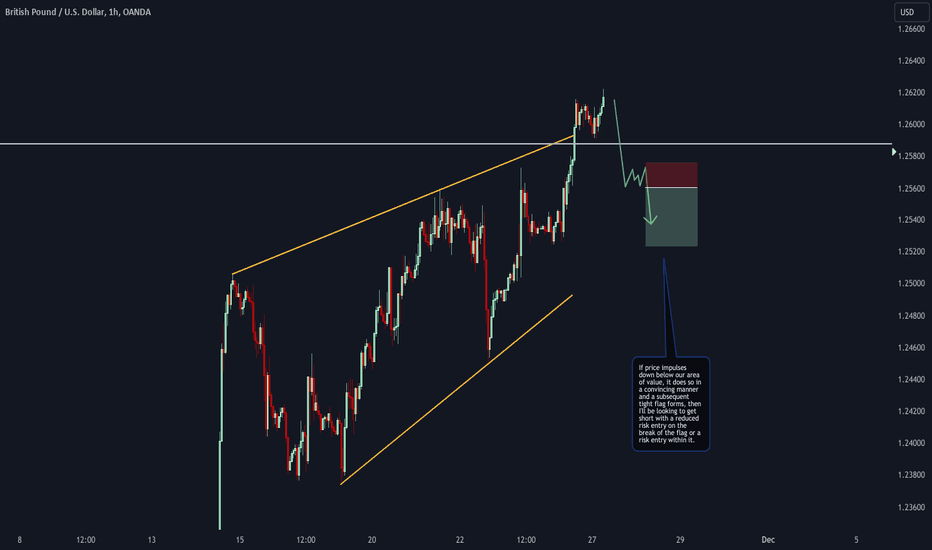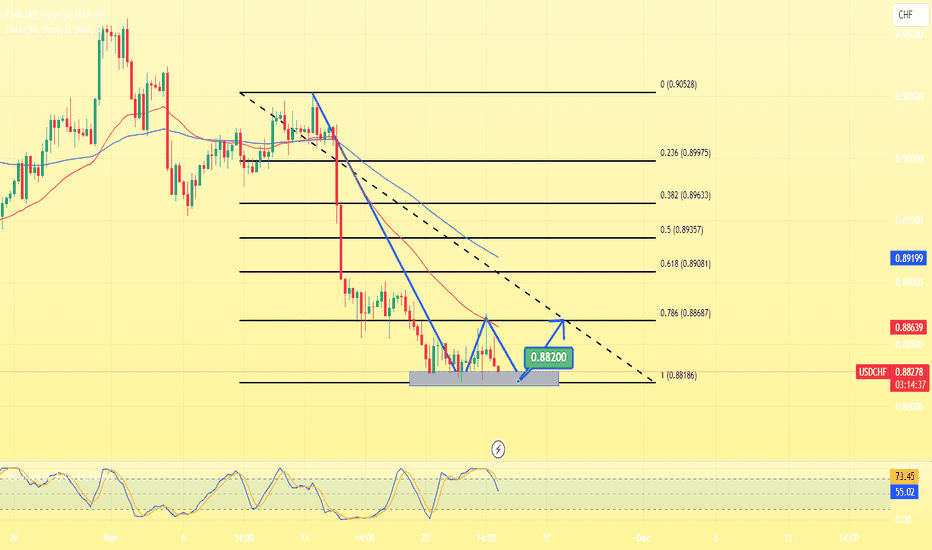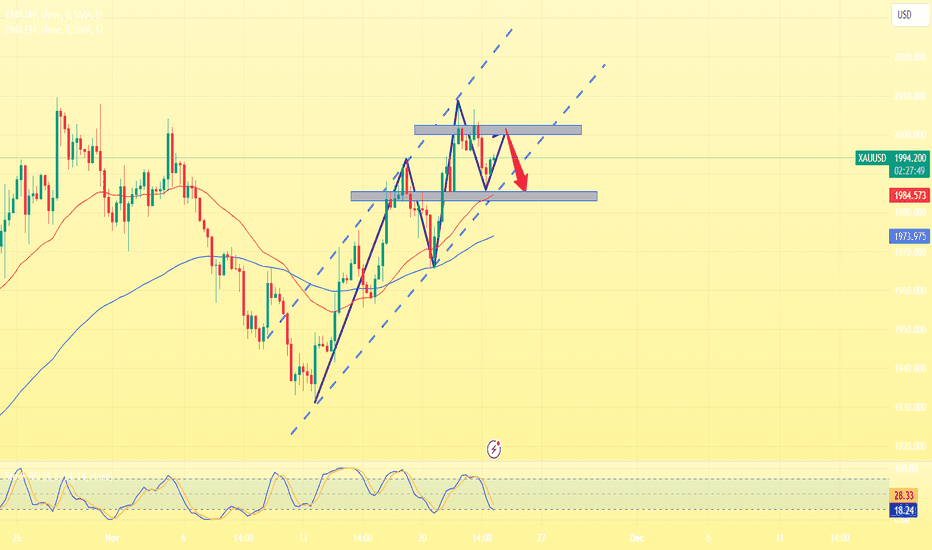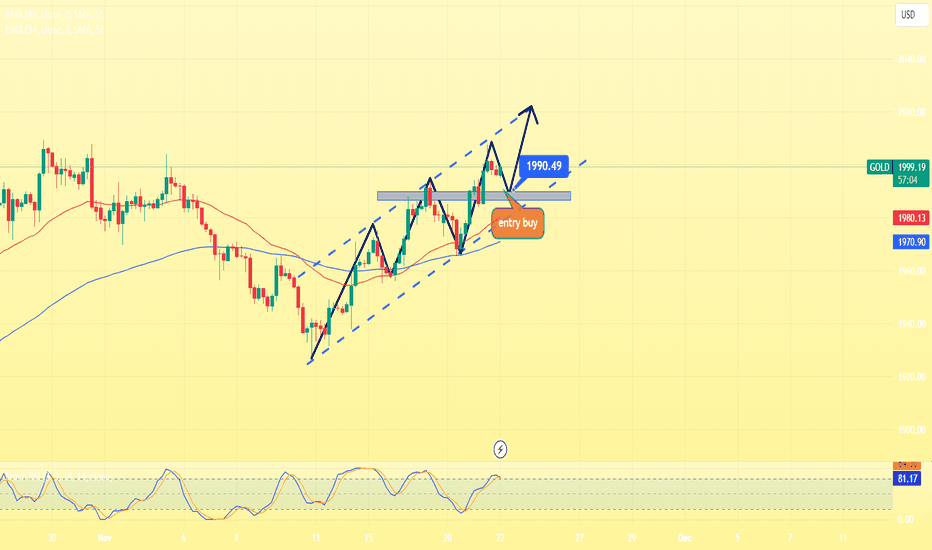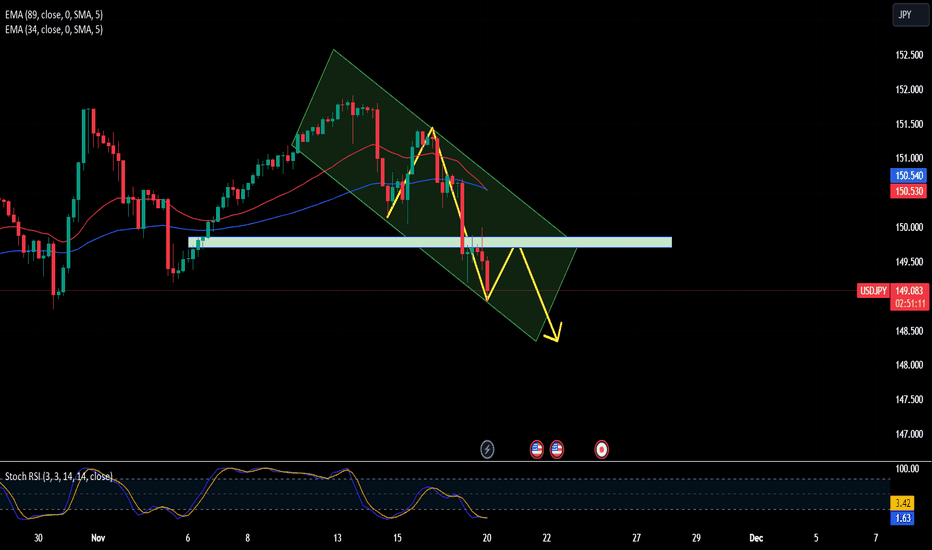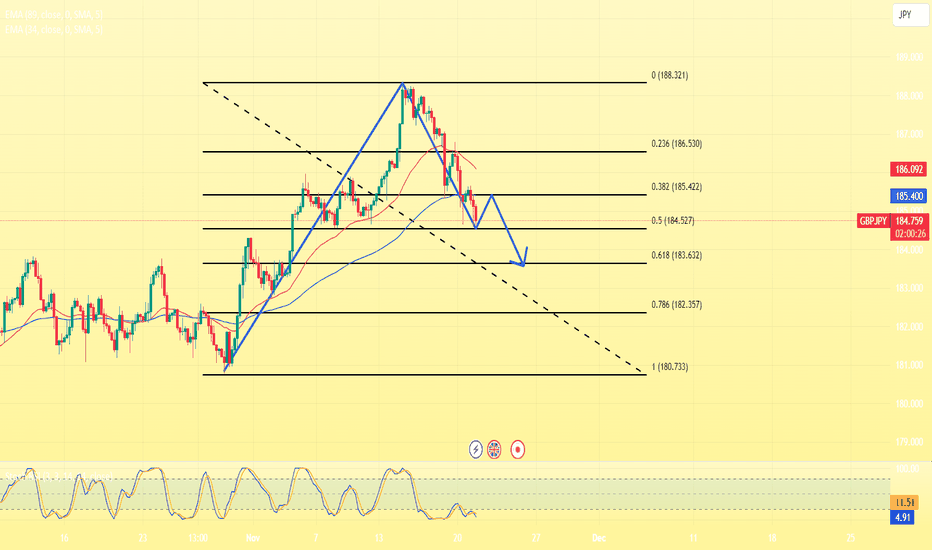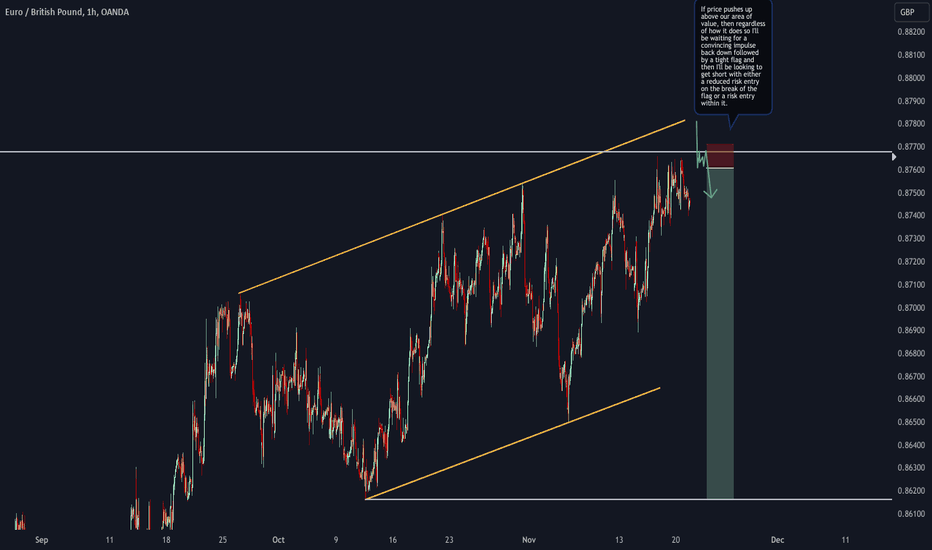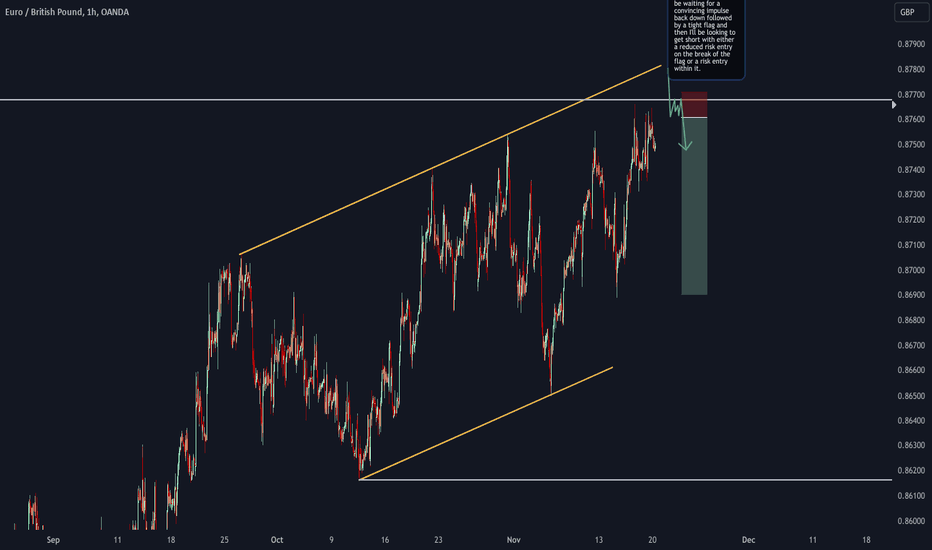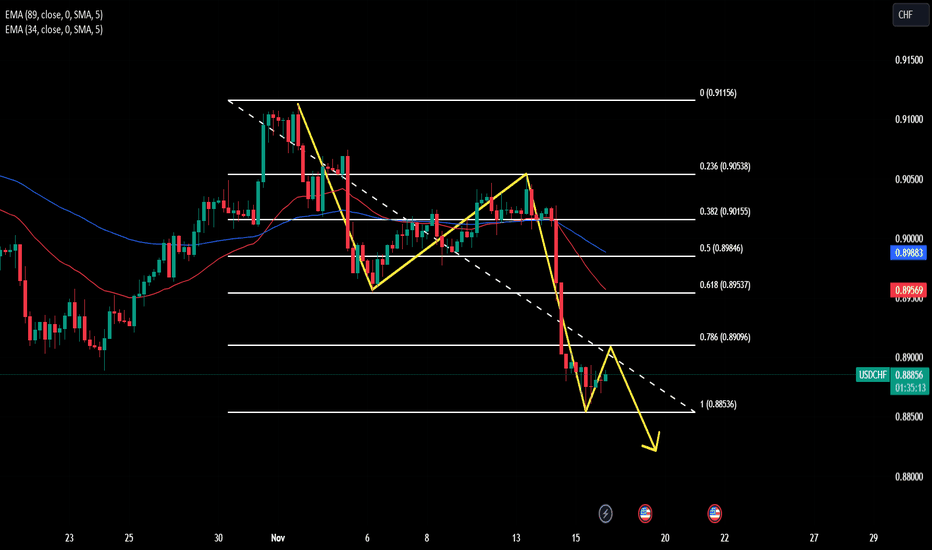EUR/USD LongEUR/USD Long
• If price pushes down to and ideally just below our area of value, then regardless of how it does so I'll be waiting for a convincing impulse back up followed by a tight flag and then I'll be looking to get long with either a reduced risk entry on the break of the flag or a risk entry within it.
• If my entry requirements are not met then I will simply wait until another setup which meets my plan materialises.
• If there's any ambiguity then I will not place a trade on this pair.
Tradingforex
EURUSD: Fed official: Interest rates will stay limited for a Interest rates are "estimated to be at their lowest level in 25 years," Williams told the New York Fed's Bretton Woods Committee meeting. "I think it is appropriate to maintain a hawkish stance for some time to fully restore balance and return inflation sustainably to our long-term target of 2%," he said.
The Fed is expected to keep interest rates on hold at its next meeting, giving it time to assess the economy after raising rates sharply from near zero in March 2022 to over 5% in July. .
At the same time, expectations are rising in the bond market that the Fed's tightening cycle will come to an abrupt end with its first rate cut in May.
"There's not a lot of sleep deprivation" given market expectations, Williams said, adding that any rate cuts would depend on inflation and how the economy progresses.
He expects inflation to continue falling toward the 2% goal, and expects the Fed's price index to fall more than 2% next year and reach the target by 2025. Government figures on Thursday showed the PCE index fell to 3% in October.
"We have taken a limited stance and things are moving in the right direction. We can now assess whether we need to do anything more."
Still, the New York Fed president said if price pressures persist longer than expected, "additional policy tightening may be necessary," and Williams, like his colleagues, believes the current political path is not sufficiently restrictive. He emphasized the need to continue monitoring the data to assess whether this is the case. .
So far, fourth quarter data shows signs of a significant decline in economic activity. Data released Thursday showed U.S. consumer spending fell in October compared to the previous month as inflation continued to slow. Inflation-adjusted personal spending rose 0.2% last month and 0.3% in September, according to the U.S. Bureau of Economic Analysis.
The report also noted that the core PCE price index increased by 0.2%. The index rose 3.5%, its lowest level since 2021.
Although he expects economic growth to remain below trend next year, he is "quite positive." Economists generally expect growth to be around 2%.
USOIL: Oil prices rose sharply due to a storm in the Black Sea Oil prices soared as storms in the Black Sea region disrupted oil exports from Kazakhstan and Russia, raising concerns about tight supply as investors awaited a major OPEC+ decision.
Severe storms in the Black Sea region have disrupted oil exports of up to 2 million barrels a day from Kazakhstan and Russia, state and port authorities said. The Ministry of Energy announced that Kazakhstan's largest oil field will see a 56% decline in total daily oil production by November 27.
Hiroyuki Kikukawa, president of NS Trading, a division of Nissan Securities, said:
“Investors are locking up short positions ahead of the OPEC+ meeting amid concerns about supply disruptions from Kazakhstan.”
“Attention is focused on OPEC+ policy and demand outlook for the second half of this year, and unless OPEC+ makes significant production adjustments, WTI is expected to remain around $76 in the short term and fluctuate above and below $5. .”
OPEC+ is scheduled to hold an online ministerial meeting on Thursday to discuss production targets for 2024, after postponing its Nov. 26 meeting. Four OPEC+ officials said negotiations would be difficult and there was a possibility of an extension of the previous agreement rather than deeper production cuts. A weak dollar and a decline in US crude oil inventories also supported crude oil prices. The dollar fell near a three-month low as market expectations grew that the Federal Reserve could start cutting interest rates early next year. Meanwhile, U.S. crude oil inventories fell by 817,000 barrels last week, market sources said, citing data from the American Petroleum Institute. On average, eight analysts polled by Reuters expected oil inventories to fall by about 900,000 barrels in the week ending Nov. 24. The US government's weekly oil inventory statistics will be released this evening.
AUD/CAD LongAUD/CAD Short
• If price pushes down to and ideally just below our area of value, then regardless of how it does so I'll be waiting for a convincing impulse back up followed by a tight flag and then I'll be looking to get long with either a reduced risk entry on the break of the flag or a risk entry within it.
• If my entry requirements are not met then I will simply wait until another setup which meets my plan materialises.
• If there's any ambiguity then I will not place a trade on this pair.
USDJPY: Asian foreign exchange increased, USD hit 3-month lowMost Asian currencies rose on Tuesday, pushing the dollar to a three-month low as confidence grew that the U.S. Federal Reserve is done raising interest rates.
However, gains for most regional currencies were limited this week as traders remained cautious on a number of key economic indicators. This week, all eyes will be on the PCE price index, the Fed's preferred inflation measure.
The Japanese yen had a particularly strong day, rising 0.3% on the day, as traders said they expect the Bank of Japan to exit its ultra-easy stance in 2024. Japan's stable inflation figures released last week further support this assumption. Thanks to the Fed's reassurance, the yen continued to recover from the 150 yen level. The immediate focus will be on Japan's industrial production and retail sales figures, which will be released later in the day. week.
DXY: The US dollar faces the risk of being sold off?Investors sold the dollar late last week at the fastest pace in a year, hoping for lower interest rates next year after the Federal Reserve ends its policy rate cut. significantly raise interest rates.
State Street, one of the world's largest asset managers, said the asset manager was prepared to sell 1.6% of its dollar positions this month, the largest monthly outflow since last November. The company said. In particular, investors have enjoyed "significant" selling every day since the release of the US employment report on November 3rd.
"The developments over the past two weeks suggest that demand for the dollar is undergoing a rapid reassessment," said Michael Metcalfe, head of macro strategy at State Street. He added that the recent sell-off in the dollar signals an end to the "extraordinary dollar glut."
``Investors are thinking, ``If interest rates are really cut, there is no need to hold so many dollars,'' the expert said.
Experts predict that the sell-off by asset managers may be just the beginning of a long-term trend among investors to reduce their exposure to US assets, with the US dollar weakening in November. This was the worst monthly performance of the year.
According to the Financial Times, a weaker U.S. dollar is beneficial for emerging countries because it helps them repay dollar-denominated loans and potentially draws investors back to developing countries. This comes after a huge sale of foreign currency-denominated bonds this year.
XAUUSD 1D) Bullish flag)🤷🚀hello traders what do you think about this analysis trading ideas 💡😁💡
(Gold weekly analysis)
Follow support and resistance Levels ✔️
(Support levels (1986)
(Support levels (1942)
Resistance levels (2007)
Resistance levels (2020)
Resistance levels (2031)
(target) 🎯 (2020)
(target) 🎯 (2031)
(Maybe retest) (1986)
follow up with my trading ideas (💡😁💡)
USDCHF: USD price dropped sharply after news of private sector eThe dollar fell against a basket of currencies late last week on news of strong U.S. business results in November, while private-sector employment fell on expectations of a slowdown in the coming months. Fourth quarter.
Earlier, Michael Brown, market analyst at Trader S&P Global, recorded the US Composite PMI Production Index on Friday.
Specifically, the value for the month remained unchanged at 50.7, as a slight increase in service sector activity offset the decline in production. Values above 50 indicate private sector expansion. The lack of significant growth in orders led to companies laying off employees, and the survey's employment index fell from 51.3 to 49.7, the first decline since June 2020. During October.
Easing the labor market will help the Fed fight inflation. Jane Foley, senior currency strategist at Rabobank, said the economic data provided further evidence of cyclical weakness in the US.
The U.S. dollar index posted its weakest monthly performance in a year amid growing expectations that the Federal Reserve will complete its interest rate hike and potentially start cutting rates next year. There is. .
EURUSD: Low valuations of euro zone bank stocks could hamper creThe European Central Bank (ECB) on Monday expressed concern about the low valuations of euro zone bank stocks, suggesting it could have a negative impact on future credit growth. Hybrid by imposing strict conditions on the borrower. Bank profits have increased significantly this year, thanks in part to higher net interest income due to higher ECB rates, but stock market valuations have not kept pace. Many banks appear to be trading at a discount to fundamentals.
The ECB has pointed out that this could lead to financial system instability in the long run. Banks that are undervalued by investors may struggle to raise new capital when they need it, the ECB said in its financial stability review report.
The central bank continued to insist that weak valuations directly lead to tighter financing conditions for the real economy. We find that banks' increased exposure to corporate credit risk and the perception of bank stocks as value stocks are major contributors to valuation stagnation.
However, the ECB also noted that these fundamentals do not fully explain current valuations. Increased uncertainty regarding future payments to shareholders may also be a factor. Meanwhile, some euro zone governments have introduced banking taxes and the ECB is considering raising interest-free reserve requirements, which could lead to lower revenues. The ECB argues that the tax risk on dividend income sources impacts valuations more than on growth stocks, whose cash flows are expected to be reinvested internally and returned to investors in the future. Far away.
NZD/USD Short, AUD/USD Short and GBP/USD ShortNZD/USD Short
• If price pushes up to and ideally just above our area of value, then regardless of how it does so I'll be waiting for a convincing impulse back down followed by a tight flag and then I'll be looking to get short with either a reduced risk entry on the break of the flag or a risk entry within it.
• If my entry requirements are not met then I will simply wait until another setup which meets my plan materialises.
• If there's any ambiguity then I will not place a trade on this pair.
AUD/USD Short
• If price pushes up to and ideally just above our area of value, then regardless of how it does so I'll be waiting for a convincing impulse back down followed by a tight flag and then I'll be looking to get short with either a reduced risk entry on the break of the flag or a risk entry within it.
• If my entry requirements are not met then I will simply wait until another setup which meets my plan materialises.
• If there's any ambiguity then I will not place a trade on this pair.
GBP/USD Short
• If price impulses down below our area of value, it does so in a convincing manner and a subsequent tight flag forms, then I'll be looking to get short with a reduced risk entry on the break of the flag or a risk entry within it.
• If my entry requirements are not met then I will simply wait until another setup which meets my plan materialises.
• If there's any ambiguity then I will not place a trade on this pair.
DXY D1 - Short SignalDXY D1
We continue to navigate to the southside here with the dollar index. During recent trade and events over the past few weeks.
Should we breach the significant 103.000 threshold, our sights are set on the next target at 101.500.
Additionally, anticipate a continued upward trajectory for XAUUSD, with all-time highs on the horizon.
NZD/USD Short, AUD/USD Short and GBP/USD ShortNZD/USD Short
• If price pushes up to and ideally just above our area of value, then regardless of how it does so I'll be waiting for a convincing impulse back down followed by a tight flag and then I'll be looking to get short with either a reduced risk entry on the break of the flag or a risk entry within it.
• If my entry requirements are not met then I will simply wait until another setup which meets my plan materialises.
• If there's any ambiguity then I will not place a trade on this pair.
AUD/USD Short
• If price pushes up to and ideally just above our area of value, then regardless of how it does so I'll be waiting for a convincing impulse back down followed by a tight flag and then I'll be looking to get short with either a reduced risk entry on the break of the flag or a risk entry within it.
• If my entry requirements are not met then I will simply wait until another setup which meets my plan materialises.
• If there's any ambiguity then I will not place a trade on this pair.
GBP/USD Short
• If price impulses down below our area of value, it does so in a convincing manner and a subsequent tight flag forms, then I'll be looking to get short with a reduced risk entry on the break of the flag or a risk entry within it.
• If my entry requirements are not met then I will simply wait until another setup which meets my plan materialises.
• If there's any ambiguity then I will not place a trade on this pair.
USDCHF: The US dollar rose on unemployment claims data, mixed The USD DXY index rose 0.30% to 103.90 as recent economic data and the Federal Reserve's minutes presented a complex scenario for investors to navigate. The increase came after the number of initial jobless claims was announced at 209,000, lower than expected. Despite this positive sign, investors are also considering a sharp decline in durable goods orders in October, down 5.4%.
The latest minutes from the Federal Open Market Committee (FOMC) show persistent concerns about inflation, suggesting that these concerns will influence future policy decisions. This led to a rise in U.S. Treasury yields across a range of maturities as investors digested mixed economic data. Looking ahead, market participants do not expect an interest rate hike in November. Instead, there are speculations that interest rates could be cut as early as March or May next year. This sentiment is reflected in the DXY technical analysis. The Relative Strength Index (RSI) remained unchanged near oversold conditions, which could indicate a resurgence of buying pressure. Meanwhile, the Moving Average Convergence Divergence (MACD) bar is still moving sideways in the red zone, indicating near-term bearish momentum.
Despite these mixed signals, the USD remains below the 20-day and 100-day SMAs (simple moving averages), but remains above the key 200-day SMA support. This position suggests that long-term bullish sentiment against the dollar may still exist despite the current bearish trend.
The dollar continues to assert its dominance in global finance, playing a central role in foreign exchange markets with a daily trading volume of more than $6.6 trillion, based on last year's data. This dominance highlights the currency's far-reaching influence and its resilience in the face of economic instability and changes in monetary policy.
GBP/CHF LongGBP/CHF Long
• If price pushes down to and ideally just below our area of value, then regardless of how it does so I'll be waiting for a convincing impulse back up followed by a tight flag and then I'll be looking to get long with either a reduced risk entry on the break of the flag or a risk entry within it.
• If my entry requirements are not met then I will simply wait until another setup which meets my plan materialises.
• If there's any ambiguity then I will not place a trade on this pair.
XAUUSD: USD strengthens on unemployment claims data and mixed ecThe US session saw an uptick in the USD on the FX market. The pre-holiday trade day in Michigan was sparked by an increase in consumer forecasts for inflation over the following one and five years, which was 4.5% and 3.2%, respectively.
The Federal Reserve minutes and recent economic data presented investors with a challenging environment to navigate, causing the US Dollar DXY Index to rise to 103.90, representing a 0.30% gain. The surge followed the announcement of 209,000 initial unemployment claims, which were lower than anticipated. Notwithstanding this encouraging indication, investors are also taking into account the notable fall of 5.4% in October's Durable Goods Orders.
The most recent Federal Open Market Committee (FOMC) minutes revealed ongoing concerns about inflation, indicating that these concerns will likely influence future policy choices.
GOLD: Gold briefly rose above $2,000 as the dollar fell.Gold surpassed the threshold of 2,000 USD/oz in Tuesday's trading session thanks to expectations that interest rates of the US Federal Reserve (Fed) have peaked. The latest meeting minutes show that the central bank is quite cautious about raising interest rates further.
Spot gold contracts increased 1.07% to 1,998,356 USD/oz after at one point during the session hitting a 3-week high of 2,007.29 USD/oz. Gold futures contracts in the US also increased 1.1% to 2,001.60 USD/oz.
USDJPY: The USD weakened without the catalyst of important econoIn the foreign exchange market, the U.S. dollar weakened, closing at the day's low, extending Tuesday's losses. Data: October building permit applications were higher than expected, but did not provide much support for the dollar. Sterling fell by nearly 40 pips following October's retail sales data, but then rebounded sharply as the US dollar weakened. The yen led the rise among major currencies at the close of trading.
GBPUSD: The British Conservative Party eyes tax cuts in the budgThe Sunday Times reported:
Britain's Chancellor of the Exchequer Jeremy Hunt is considering cutting income tax and national insurance in a bid to improve his standing in the polls.
Jeremy Hunt told Sky News:
“We want to responsibly reduce our tax burden.”
"The only thing we won't do is not give any tax cuts that could cause inflation."
It could allow heirs to defer taxes and consider instead giving tax breaks to low- and middle-income earners.
GBPJPY: Comments on GBPJPY todayToday, traders will depend on dollar sentiment, risk appetite and bond market developments. There are no significant data published in Europe:
14:00: Switzerland's October trade balance data
17:15: BOE policymakers will testify before parliament on monetary policy, inflation and the UK's economic outlook
XAUUSD: Gold briefly surpassed the $2,000 threshold as the dollaWhat do you think about gold? or
It surpassed the $2,000 per ounce threshold in trading on Tuesday on expectations that US Federal Reserve interest rates have peaked. The latest minutes show the central bank is very cautious about raising rates further.
Spot gold contracts rose 1.07% to $1,998,356/oz after hitting a three-week high of $2,007.29/oz during trading. U.S. gold futures also rose 1.1% to $2,001.60 an ounce. "The bulls are aggressively stocking up on gold ahead of the Thanksgiving holiday," said Tai Wong, an independent metals trader based in New York.
Fed officials agreed at their most recent policy meeting that interest rates could only rise if future information suggests that inflation will decline, according to minutes released Tuesday. Development has not made the necessary progress.
The dollar has fallen to its lowest level in two-and-a-half months, making gold less attractive to holders of other currencies. The yield on the 10-year U.S. Treasury bond is also hovering around the two-month low hit last week.
EUR/GBP ShortEUR/GBP Short
• If price pushes up above our area of value, then regardless of how it does so I'll be waiting for a convincing impulse back down followed by a tight flag and then I'll be looking to get short with either a reduced risk entry on the break of the flag or a risk entry within it.
• If my entry requirements are not met then I will simply wait until another setup which meets my plan materialises.
• If there's any ambiguity then I will not place a trade on this pair.
GBP/CHF Long and EUR/GBP ShortGBP/CHF Long
• If price pushes down to and ideally just below our area of value, then regardless of how it does so I'll be waiting for a convincing impulse back up followed by a tight flag and then I'll be looking to get long with either a reduced risk entry on the break of the flag or a risk entry within it.
• If my entry requirements are not met then I will simply wait until another setup which meets my plan materialises.
• If there's any ambiguity then I will not place a trade on this pair.
EUR/GBP Short
• If price pushes up above our area of value, then regardless of how it does so I'll be waiting for a convincing impulse back down followed by a tight flag and then I'll be looking to get short with either a reduced risk entry on the break of the flag or a risk entry within it.
• If my entry requirements are not met then I will simply wait until another setup which meets my plan materialises.
• If there's any ambiguity then I will not place a trade on this pair.
USDCHF: Weak US CPI weighs heavily on the dollarAs anticipation that the Federal Reserve would terminate the monetary tightening cycle increased due to slowing U.S. inflation, the U.S. dollar made a slight recovery in early European trading on Wednesday.
The Dollar Index, which measures the value of the US dollar against a basket of six other currencies, increased by 0.1% to 104.057 at 03:05 ET (08:05 GMT), not far from a two-month low on Friday. In three, 103.98.
Tuesday saw a significant decline in the value of the US dollar after statistics revealed that US consumer prices were unchanged in October but increased 3.2% year over year, less than anticipated, following a 3.7% increase in September.
The most important factor in determining whether the Fed will continue to tighten policy is stable inflation, particularly when inflation increased more than
